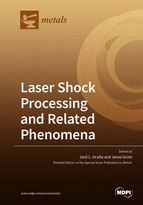Laser Shock Processing and Related Phenomena
A special issue of Metals (ISSN 2075-4701). This special issue belongs to the section "Corrosion and Protection".
Deadline for manuscript submissions: closed (30 September 2019) | Viewed by 47939
Special Issue Editors
Interests: laser shock processing; laser additive manufacturing; materials characterization
Special Issues, Collections and Topics in MDPI journals
Interests: material characterization; microstructure; mechanical properties; mechanical behavior of materials; materials processing; advanced materials; surface engineering; heat treatment; coatings; corrosion
Special Issue Information
Dear Colleagues,
Laser Shock Processing (LSP) has been developed as an effective technology for improving the surface and mechanical properties of metallic alloys. In addition, it is an emerging technology that is being manufactured with direct competitive advantages in comparison with other established technologies, such as shot peening, whether in manufacturing or maintenance/repair operations.
The level of maturity of Laser Shock Processing has been increasing during the last few years, and several thematic international conferences have been organized (the 7th ICLPRP will be held in Singapore, June 17–22, 2018), where different developments on a number of key aspects have been discussed, i.e.:
- Fundamental Laser Interaction Phenomena
- Material Behavior at High Deformation Rates/Under Intense Shock Waves
- Laser Sources and Experimental Processes Implementation
- Induced Microstructural/Surface/Stress Effects
- Mechanical and Surface Properties Experimental Characterization and Testing
- Numerical Process Simulation
- Development and Validation of Applications
- Comparison of LSP to Competing Technologies
- Novel Related Processes
which have been treated by renowned specialists, providing a firm basis for the further development of the technology in its path to industrial penetration.
However, the application of LSP (and related technologies) to different types of materials, envisaging different types of applications (ranging from the always demanding aeronautical/aerospatial field to the energy generation, automotive and biomedical fields), still requires extensive efforts in the elucidation and mastering of different critical aspects, which deserve deep analysis as a necessary step prior to their industrial readiness level.
This Special Issue aims to collect, mainly for the use of LSP application developers in different target sectors, a number of high quality and relevant papers representing the present state-of-the-art of the technology, which can be also useful to newcomers in realizing its wide and relevant prospects as a key manufacturing technology.
Consequently, and in an additional and complementary way to papers presented at the thematic ICLPRP Conferences, a call is made to those authors willing to prepare a high quality and relevance paper for their submission to the journal (https://www.mdpi.com/journal/metals), with the confidence that their work will make part of a fundamental collection providing the present state-of-the-art of the LSP technology.
Prof. Dr. José L. Ocaña
Guest Editor
Manuscript Submission Information
Manuscripts should be submitted online at www.mdpi.com by registering and logging in to this website. Once you are registered, click here to go to the submission form. Manuscripts can be submitted until the deadline. All submissions that pass pre-check are peer-reviewed. Accepted papers will be published continuously in the journal (as soon as accepted) and will be listed together on the special issue website. Research articles, review articles as well as short communications are invited. For planned papers, a title and short abstract (about 100 words) can be sent to the Editorial Office for announcement on this website.
Submitted manuscripts should not have been published previously, nor be under consideration for publication elsewhere (except conference proceedings papers). All manuscripts are thoroughly refereed through a single-blind peer-review process. A guide for authors and other relevant information for submission of manuscripts is available on the Instructions for Authors page. Metals is an international peer-reviewed open access monthly journal published by MDPI.
Please visit the Instructions for Authors page before submitting a manuscript. The Article Processing Charge (APC) for publication in this open access journal is 2600 CHF (Swiss Francs). Submitted papers should be well formatted and use good English. Authors may use MDPI's English editing service prior to publication or during author revisions.
Keywords
- Laser shock processing
- fundamental phenomena
- mechanical properties
- surface properties
- residual stresses
- crack propagation
- fatigue
- corrosion
- materials behaviour
- numerical simulation







